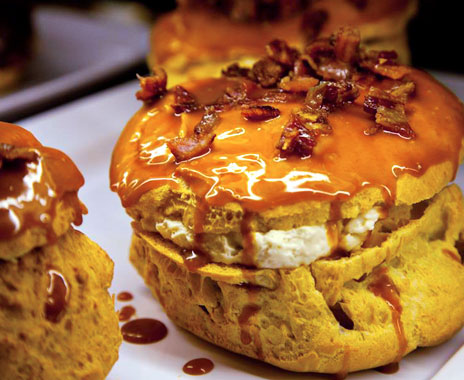For many quick-service operators, rolling out a successful dessert platform is a matter of taking a big risk. Dessert isn’t always top of mind for customers who are in and out of a restaurant, while pressure is on for flavors to be innovative but also compliment the menu.
The risk involved may be why, according to a new Food Genius report, quick-service restaurants are the most underrepresented market in desserts.
“[Quick-service restaurants] make up 20 percent of the menus nationally that we track, but when we look at dessert sections, the distribution is lower, at 15 percent. All other segments are either higher or match the benchmark,” says Eli Rosenberg, vice president of marketing for Food Genius, in an email to QSR.
According to the report, desserts are available at 68 percent of restaurant locations nationwide and make up 10 percent of all items on menus. Fifty percent of independent restaurants offer dessert, while more than 75 percent of chain restaurants do.
Christine LaSorda, founder of A Baker’s Tale, a dessert concept based in Chicago, says the operational strain of dessert might be scaring some operators away from serving it.
“I think people are a little bit nervous about incorporating desserts,” she says. “They think, ‘Is it going to put a strain on my kitchen? I want to focus more on the food,’ and they don’t want to put the strain out for that. But it’s a really easy way for them to increase their check average, and people [want] to get more adventurous with sweets.”
At A Baker’s Tale, those adventurous sweets include items like the Honey Blueberry Basil Cupcake, which LaSorda says people are scared to try at first, but then end up enjoying.
Still, while it’s important to have daring innovations, LaSorda says, it’s also important to have the classics so customers, especially kids, feel comfortable.
Boston-based fast casual Boloco offers chocolate chip cookies, which Eric Kinniburg, director of culinary for Boloco, says was the result of exploring dessert items that required little labor. Shakes and smoothies, meanwhile, make up the bulk of Boloco’s dessert menu.
Kinniburgh says the shakes and smoothies serve two purposes: to be ordered as a dessert or as a separate meal occasion. Items like the Tropi-Kale smoothie, made with baby kale, mango, cucumber, celery, apple juice, and honey, are intended to fill in as a meal.
He says around 25 percent of customers order dessert across all locations.
Boloco tries to balance the menu between healthy and indulgent items, Kinniburgh adds. For example, an Orange Dreamsicle Shake debuts next week, while one popular secret menu item is a flour tortilla with Nutella, melted cheese, and crispy bacon.
“If it’s indulgent, we get a little bit more to play with, because we don’t have to be so concerned with sugar content and fat content. It’s about what people are really going to dig,” Kinniburgh says. “So if we do that, we try to offset it with something that’s a little more focused on health.”
He says shakes require more labor, but have more mainstream appeal and draw in customers because they are familiar with the item.
Food Genius’s report shows dairy and fruit are mentioned more often on dessert menus than candies like chocolate, caramel, and fudge. Mediterranean and Indian flavors, meanwhile, are on the rise in the dessert space, from Gulab Jamun to Baklava. Rosenberg says the growth of ethnic flavors is caused by more restaurant locations serving ethnic food, driving up the popularity of classic desserts from those cuisines.
“This is also likely in response to the growth of the Millennial consumer set and their tastes skewing toward more unique flavors, which are found in these ethnic cuisines,” he says.
But, unlike some trends in the quick-service industry, dessert inspiration lies in the chains, not the independent restaurants, according to the report.
“The variety of desserts and unique concepts we see in the dessert section are coming from chains, things like the dessert taco or dessert pizza,” Rosenberg says. “This might be because they take time to develop new concepts for the dessert menu that have marketability and are aligned with their brand, versus independents who tend to focus on the mainstays of the dessert menu.”
No matter where the inspiration comes from, LaSorda says, operators would be wise to jump onboard the dessert bandwagon as consumer demand intensifies.
“I think that desserts are on the rise,” she says. “People used to think of them as an afterthought in restaurants.”







